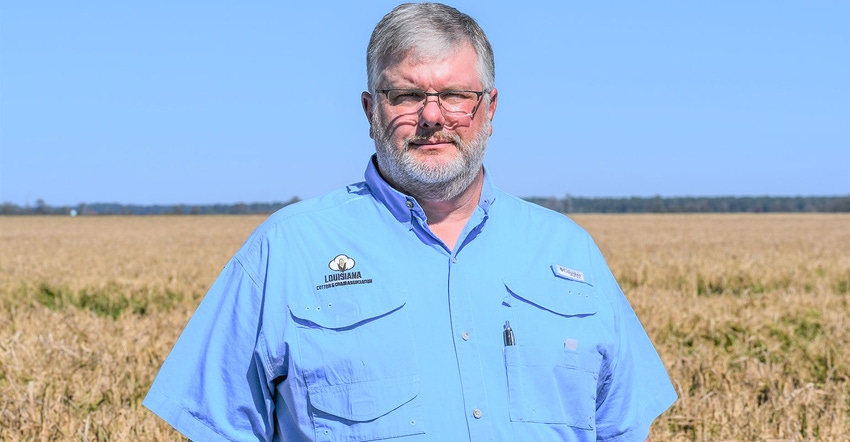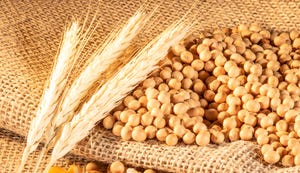
Despite the threat of hurricanes, many Louisiana farmers had an excellent crop, thanks to good weather during the growing season.
Heath Herring, first vice president of the Louisiana Cotton and Grain Association and recently elected president whose term begins in February 2021, farms cotton, corn, soybeans and rice. Using technology and conservation practices, Herring helps preserve soil health on his farm in Newellton, Louisiana, in Tensas Parish.
Harvesting amid hurricanes
Overall, it has been a good harvest season around Tensas Parish, according to Herring.
"There are still some crops in the field," he said on Oct. 13. "We have some cotton and soybeans left to be harvested. Most of the corn is harvested, except for a few acres. I would say corn is 99.5% done, and probably 80-85% of the rice is out of the fields.
"We dodged a bullet with Laura where we are in the state. I have some friends on the other side of the state that were not so lucky. With hurricane Delta, the wind was not too bad. I have heard reports from a friend of mine north of me that some people had a lot of cotton on the ground from the wind. The wind didn't affect us quite as bad, but we did get around six inches of rain."
With the fields wet from hurricane Delta, finishing the harvest and fieldwork promptly is a concern.
"With the days being shorter and the weather cooler, it is going to take some time to get the ground dried back out," Herring said. "There's still quite a bit of fieldwork to be done.
"I would say 70% of my acres I have fieldwork to do, but the problem we've had in Tensas Parish in the last several years is wet falls, which delays fieldwork. And at some point, you pray it dries up during the winter if you can't finish the fieldwork in the fall, so you're ready to start planting as soon as you can in the spring."
Good growing season
Tensas Parish experienced good weather conditions during the growing season.
"We had some hot periods like we always do, but we also had mild weather sometimes, especially in the evenings, and nights were cooler," he said. "It helped everything thrive."
Herring said he picked one of the best cotton crops he has ever had as well as cut an excellent soybean and corn crop.
"Overall, we had a good crop this year, and most people I know have had an excellent crop as well," he said. "We certainly needed this. It's been tough, but that's farming. It is up and down year from year, and you have to put your best foot forward, make the best decisions you can, and lean into it as one friend says."
Tech to preserve the land
AutoTrac guidance is a big help on Herring's farm.
"We use AutoTrac at every opportunity we can," Herring said. "There's also a program that John Deere has called Surface Water Pro used to record water furrow going through the field. As you make your ditches, it records it and enhances field drainage. We use it for every kind of fieldwork we have, and we use it with our combines and cotton pickers for harvesting."
When the fields are surveyed and planting is recorded, Herring gives the data to a consultant. Herring takes the elevation data and draws the levees into a program to put in the tractors.
"When we are doing fieldwork, we don't have to follow a crooked line," he said. "We know that the tractors drive our levees exactly where they need to be."
The farm also uses variable rate application to spread fertilizer and lime.
"We get our soil tested and use the maps from the soil test to see if one area of the field needs a ton of lime and another area needs half a ton," Herring said. "Instead of coming up with an average and just putting too much lime where none is needed and not enough where it needs more, we concentrate on the areas where it needs to be applied."
Herring is considering trying variable rate spraying.
"I know people who use variable rate spraying on their fields to put out a growth regulator to slow cotton down to make it produce more," he said. "You will have a prescription put in the sprayer, and it sprays the chemical, fertilizer, or growth regulator as needed throughout the field.
"I haven't seen a reason to try variable rate spraying with a growth regulator yet because my fields are pretty consistent and are one soil type. They don't vary much, but some fields do. Some ground will go from sandy soil to heavy, black clay, and the crops respond differently to those soils. In those situations, it comes in handy to use the technology to put out what you need in certain areas. If you put out a blanket application across fields, some will get too much while others not enough."
Saving soil and money
Herring is partnered with the USDA NRCS office and EQIP (Environmental Quality Incentives Program) to put control structures in for drainage.
"Sometimes, we leave grassy borders around the fields for filtering out fertilizers and to prevent erosion," he said. "I also rejoined the CSP program, and there's a lot of new things we're going to do to incorporate conservation practices on the farm. As a part of the program, we will do things like holding water in the winter for waterfowl, planting pollinator habitat for bees, planting high residue crops, and leaving residue in the field in the fall for erosion prevention. You also earn some money through the program, which certainly helps during bad economic times, but we're also doing a lot of good conservation practices for the land and wildlife.
"Sustainability is a big word these days, and a lot of people think that farmers are just out there farming and haven't changed in a hundred years. We care about sustainability and conservation and doing our part to care for the soil, reduce pesticide use, and make many other changes to care for the land. It makes sense to do all those things, even if you simply look at it in terms of money. If you use variable rate chemicals and fertilizer, you're doing that to save money as well as to preserve soil health."
Passed from son to son
With the help of new equipment and technology advancements, the family farm has continued to grow through generations.
"I'm a third-generation farmer," said Herring. "My grandfather started farming in the 50s, and my father came back home and started farming in 1979. Shortly thereafter, he took over the farm. I came back in 1997 and started farming; when my father retired, he passed the farm over to me about 20 years ago."
Herring said technology has been a big asset to growing the farm.
"With technology, the farm has changed in many ways," he said. "Number one would be our genetics, mainly Roundup Ready crops.
"Many family farms have gotten bigger in recent years, and if it wasn't for the speed and the design of new equipment as well as technology, like genetics, to help us, it would be tough to farm many acres. Here in the mid-South, our window of opportunity to work is so short. It seems like we're always trying to get things done before the next rain event, so technology is a huge help for more efficient production."
About the Author(s)
You May Also Like




